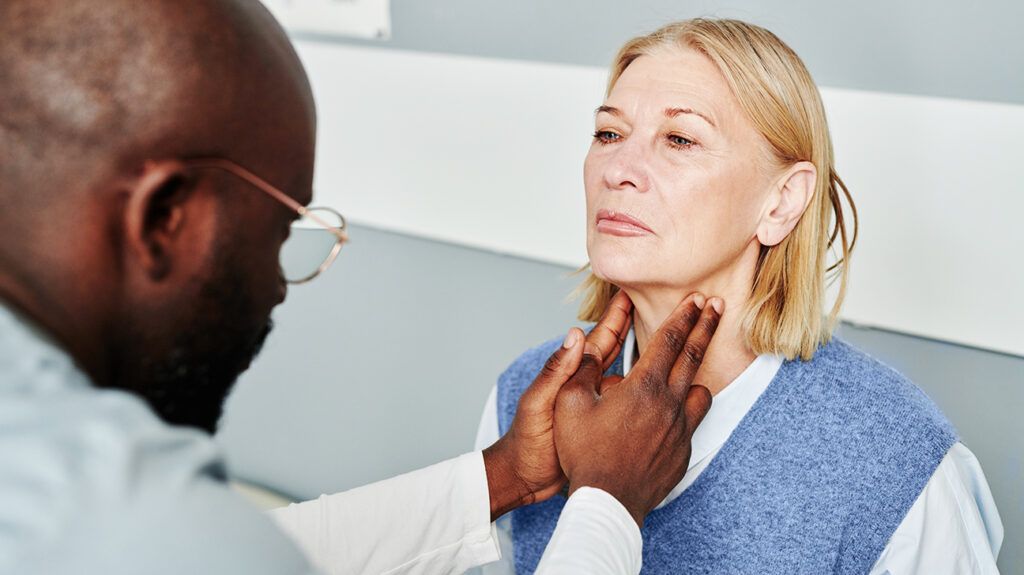Oculopharyngeal muscular dystrophy (OPMD) is a rare inherited disorder that causes weakness in the eye and throat muscles. It may lead to drooping eyelids and swallowing difficulties.
Muscular dystrophy (MD) is a group of conditions that causes muscle weakness to increase over time. Some types of MD cause mobility issues, but the types vary in which muscles they affect, how severe their symptoms are, and when symptoms first start to develop.
OPMD affects the muscles around the eyes and throat, sometimes also affecting the tongue, shoulders, and hips. Treatments can help manage symptoms and improve life expectancy.
Read on to learn more about the symptoms and causes of OPMD. This article also looks at how doctors diagnose the condition, its treatment options, and more.

Most OPMD symptoms first start to develop after the age of 40 years. Symptoms can include:
- drooping eyelids, known as ptosis
- difficulties swallowing, known as dysphagia
- weakness in the shoulder and hip muscles
- reduced eye movements
People might eventually need a cane or walker. Rarely, a person with OPMD may require the use of a wheelchair to move around.
The first sign of dysphagia in people with OPMD is difficulty swallowing dry food. As the condition progresses, liquids, such as beverages or saliva, may become more difficult to swallow. This can lead to a buildup of saliva and a voice that sounds wet. OPMD might also cause wasting and weakness of the tongue muscles.
Some people have a severe form of OPMD that develops before they are 45 years old. This can lead to a loss of independent mobility by 60 years of age, as well as:
- reduced cognitive abilities
- reduced nerve function
- depression
- delusions
Learn more about muscular dystrophy.
OPMD passes from parents to children through changes, or mutations, to a single gene called PABPN1.
The condition is autosomal dominant, meaning only one parent needs to pass on the gene for the condition to have a 50% chance of developing. Some people have two copies of the mutation, which can lead to more severe symptoms.
PABPN1 helps prevent the breakdown of RNA, which provides the genetic guidelines for how the body uses proteins and moves them around cells.
According to the Centers for Disease Control and Prevention (CDC), fewer than
The National Organization of Rare Disorders (NORD) suggests OPMD is more common among certain populations, including:
- people of French descent living in Quebec, Canada
- Bukhara Jewish people in Israel
- a Hispanic population in New Mexico
Learn more about autosomal inheritance.
A genetic blood test can confirm that a person has a mutation in the PABPN1 gene.
A doctor will also look for drooping eyelids and swallowing issues and take a detailed medical history.
Treatments for OPMD focus on managing symptoms and reducing the risk of severe complications.
These include:
- Blepharoptosis repair: This is a type of plastic surgery procedure that involves raising the eyelids, allowing individuals with severe ptosis to see. However, due to muscle weakness, people with OPMD may not be able to close their eyes after the procedure. Not all people with OPMD have ptosis severe enough to warrant surgery.
- Cricopharyngeal myotomy: People with severe dysphagia due to OPMD may benefit from this procedure. It involves cutting the cricopharyngeal muscle in the throat, which relaxes the muscle to allow food and fluids to pass into the stomach.
- Feeding tube: People with severe dysphagia may not be able to consume food by mouth. A surgeon may insert a feeding tube directly into the stomach to avoid the need for swallowing. This may prevent infections, such as pneumonia.
- Orthopedic devices: Orthopedic devices and mobility aids — such as walkers, leg braces, and canes — may assist with mobility for those with hip muscle issues. Physical therapy may also help.
A doctor can help a person create a treatment plan based on the severity of their condition and the symptoms they experience.
Drooping eyelids due to OPMD should not reduce a person’s ability to see well. However, severe OPMD can cause drooping eyelids to obstruct vision if the eyelids droop over the pupils.
As dysphagia worsens, it can lead to difficulties when swallowing food and fluids. They can enter the lungs instead of the stomach, leading to a complication called aspiration. This can cause infections, such as aspiration pneumonia.
Beginning effective treatment as early as possible for OPMD may help reduce the likelihood of severe complications.
What is the life expectancy with oculopharyngeal muscular dystrophy?
OPMD has little effect on a person’s life expectancy if they manage the condition well, according to a
Oculopharyngeal muscular dystrophy vs. myasthenia gravis: What is the difference?
Myasthenia gravis (MG) causes similar symptoms to OPMD, including ptosis, dysphagia, and mobility problems. However, MG symptoms can develop at any age, while OPMD symptoms generally develop after the age of 40 years.
MG can also affect muscles related to breathing, which can cause a serious complication called myasthenic crisis. OPMD occurs due to a genetic mutation. However, MG occurs because the immune system attacks certain parts of the muscles.
Oculopharyngeal muscular dystrophy (OPMD) is a genetic condition that causes progressive muscle weakness around the eyes and throat. The main symptoms are drooping eyelids and swallowing difficulties that get worse over time. However, OPMD can also cause hip weakness and mobility issues.
Doctors can diagnose OPMD with a genetic test. Surgery, physical therapy, feeding tubes, and mobility aids may help a person with OPMD manage symptoms and reduce the risk of complications.
